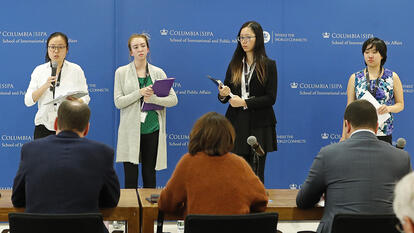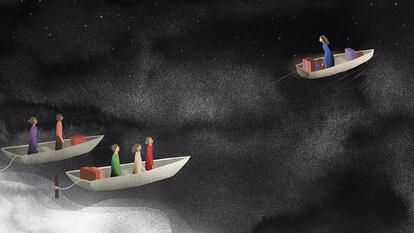
Students Dig Into Wellesley’s History—Literally
More than a century ago, College Hall, the heart of the Wellesley College campus, burned to the ground. Now Elizabeth Minor ’03, lecturer in anthropology, and her students are searching for artifacts that survived the blaze.
When it was built in 1875, the beautiful hall was one of the largest brick buildings in the United States. It housed all of Wellesley’s students and some of its faculty and staff, classrooms and laboratories, and a dining hall, library, chapel, gym, and museum. But one fateful day, personal belongings, art, and much more were destroyed. Early in the morning of March 17, 1914, students woke to smoke and alarm bells. They responded rapidly, donning their outerwear and rushing outside in proper Wellesley fashion. An uncredited author from the Wellesley News edition that week described watching the fire in shocked horror: “… the roar of devastating fury, the crackle of brands, the smell of burning wood and melting iron filled the air, but almost no sound came from the human beings who saw the irrepressible blaze consume everything but the brick walls.”
But in her course ANTH 252: The Archaeology of Wellesley: College Hall Fire Field School, Minor has found that not all was lost. Over the past several years, Minor and her students have found many artifacts while excavating the area where College Hall once stood, by Tower Courtyard overlooking Lake Waban, including a skull fragment from an anatomical human skeleton and many melted and charred items.
You get to know Wellesley’s history because you are going to be part of it. ...[F]ire can destroy, but there will be a memory, and students today make it a living memory.
Julz Vargas ’24
“As a student I was curious if anything was left from the fire, especially after learning about Pompeii and thinking about how this was Wellesley’s Pompeii moment,” said Minor. “I started the dig to give students an accessible opportunity to try out field science, where they didn’t have to spend thousands of dollars to go abroad for the summer before they knew if they liked fieldwork or not. My goal was to create an inclusive space where students can build their own community connections as they explore their collective past.”
During the most recent excavation, which took place this past fall, Minor says the “coolest thing” students found was a tiny silver thimble, barely fitting a pinkie finger, inscribed to “Mamie.” By combing through letters and records in the Wellesley College Archives, the team may have identified its owner: a student who used the nickname during that period.
Another significant find from this past fall’s dig was sherds, or broken pieces of pottery. While students assumed that finding pottery in an archaeological dig is fairly normal, Minor says in this instance it was “completely surprising.” She expected to see a sherd of porcelain when a student announced that they had found part of a pot. It turned out to be ancient Mediterranean pottery, definitely unexpected in excavations in Massachusetts. Minor’s best guess is that a professor of archaeology had found some pot sherds during a tour of the Mediterranean and brought them back to the College prior to the fire.
“You get to know Wellesley’s history because you are going to be part of it,” said Julz Vargas ’24. “The pillars by Tower Court are visible remnants that provide a place for students to gather today, and they were put there by a former student who recognized their importance. … [F]ire can destroy, but there will be a memory, and students today make it a living memory.”
To encourage more students to explore the history of Wellesley, public outreach was a major component of the course. “At Wellesley we test out public outreach methods that we can use at the sibling project I co-direct in Sudan,” said Minor. “Students here document their field experiences and make outreach materials that I bring to the Es-Selim R4 Archaeology Project, at the site of a Bronze Age Nubian settlement, starting a dialogue between international community members about how the past can be relevant in their lives today. We found the 100-year-old thimble in Tower Court, and a 4,500-year-old bone needle in Sudan!”
Students “tabled” in heavily trafficked spaces like the Lulu Chow Wang Campus Center, offering curious passersby a chance to try excavation for themselves in sandboxes filled with various items (I found a button!). They also held events like the College Hall Hop, a period-appropriate dance with replica dance cards, and they even created a time capsule for students of the future to find.
“Archaeology trains you to be aware of your surroundings. You get an immediate gratification and see your results,” said Kelly Giudice CE/DS ’26.
Megan Rodriguez-Hawkins ’25 loved seeing people’s excitement when they found even a tiny piece of glass. “That piece of glass becomes important,” said Rodriguez-Hawkins, “because we all discovered it, it made history more real. You could walk past the site and know that you were part of that.”
ANTH 252: The Archaeology of Wellesley: College Hall Fire Field School will be offered through the anthropology department again in fall 2023.
See more photos and a video in our Instagram post.
For more information about the College Hall fire, see “Up in Flames” by Lisa Scanlon Mogolov ’99 in the spring 2014 issue of Wellesley magazine.



